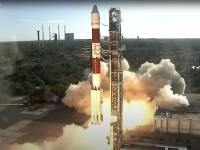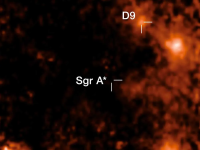Earth bids farewell to its temporary ’mini moon’ that is possibly a chunk of our actual moon
Author of the article:Associated Press
Associated Press
Marcia Dunn
Published Nov 24, 2024 • 1 minute read
CAPE CANAVERAL, Fla. (AP) — Planet Earth is parting company with an asteroid that’s been tagging along as a “mini moon” for the past two months.
The harmless space rock will peel away on Monday, overcome by the stronger tug of the sun’s gravity. But it will zip closer for a quick visit in January.
NASA will use a radar antenna to observe the 33-foot (10-meter) asteroid then. That should deepen scientists’ understanding of the object known as 2024 PT5, quite possibly a boulder that was blasted off the moon by an impacting, crater-forming asteroid.
While not technically a moon — NASA stresses it was never captured by Earth’s gravity and fully in orbit — it’s “an interesting object” worthy of study.
The astrophysicist brothers who identified the asteroid’s “mini moon behaviour,” Raul and Carlos de la Fuente Marcos of Complutense University of Madrid, have collaborated with telescopes in the Canary Islands for hundreds of observations so far.
Currently more than 2 million miles (3.5 million kilometres) away, the object is too small and faint to see without a powerful telescope. It will pass as close as 1.1 million miles (1.8 million kilometres) of Earth in January, maintaining a safe distance before it zooms farther into the solar system while orbiting the sun, not to return until 2055. That’s almost five times farther than the moon.
First spotted in August, the asteroid began its semi-jog around Earth in late September, after coming under the grips of Earth’s gravity and following a horseshoe-shaped path. By the time it returns next year, it will be moving too fast — more than double its speed from September — to hang around, said Raul de la Fuente Marcos.
NASA will track the asteroid for more than a week in January using the Goldstone solar system radar antenna in California’s Mojave Desert, part of the Deep Space Network.
Current data suggest that during its 2055 visit, the sun-circling asteroid will once again make a temporary and partial lap around Earth.

 torontosun.com
torontosun.com
Author of the article:Associated Press
Associated Press
Marcia Dunn
Published Nov 24, 2024 • 1 minute read
CAPE CANAVERAL, Fla. (AP) — Planet Earth is parting company with an asteroid that’s been tagging along as a “mini moon” for the past two months.
The harmless space rock will peel away on Monday, overcome by the stronger tug of the sun’s gravity. But it will zip closer for a quick visit in January.
NASA will use a radar antenna to observe the 33-foot (10-meter) asteroid then. That should deepen scientists’ understanding of the object known as 2024 PT5, quite possibly a boulder that was blasted off the moon by an impacting, crater-forming asteroid.
While not technically a moon — NASA stresses it was never captured by Earth’s gravity and fully in orbit — it’s “an interesting object” worthy of study.
The astrophysicist brothers who identified the asteroid’s “mini moon behaviour,” Raul and Carlos de la Fuente Marcos of Complutense University of Madrid, have collaborated with telescopes in the Canary Islands for hundreds of observations so far.
Currently more than 2 million miles (3.5 million kilometres) away, the object is too small and faint to see without a powerful telescope. It will pass as close as 1.1 million miles (1.8 million kilometres) of Earth in January, maintaining a safe distance before it zooms farther into the solar system while orbiting the sun, not to return until 2055. That’s almost five times farther than the moon.
First spotted in August, the asteroid began its semi-jog around Earth in late September, after coming under the grips of Earth’s gravity and following a horseshoe-shaped path. By the time it returns next year, it will be moving too fast — more than double its speed from September — to hang around, said Raul de la Fuente Marcos.
NASA will track the asteroid for more than a week in January using the Goldstone solar system radar antenna in California’s Mojave Desert, part of the Deep Space Network.
Current data suggest that during its 2055 visit, the sun-circling asteroid will once again make a temporary and partial lap around Earth.

Earth bids farewell to its temporary ’mini moon’ that is possibly a chunk of our actual moon
The harmless space rock will peel away on Monday, overcome by the stronger tug of the sun's gravity.
![emily_calandrelli_space-e1732729940393[1].jpg emily_calandrelli_space-e1732729940393[1].jpg](https://forums.canadiancontent.net/data/attachments/24/24172-15e365ea56ce5ee067025447ed828008.jpg)















![milky-way-1[1].jpg milky-way-1[1].jpg](https://forums.canadiancontent.net/data/attachments/24/24544-ea0d33401eb1740ecc5f8180d16d1d7a.jpg)




![nasa-sun-flyby[1].jpg nasa-sun-flyby[1].jpg](https://forums.canadiancontent.net/data/attachments/24/24672-55d6e5b6f4ccbe565e196f375dc0c947.jpg)

![nasa-sun-flyby[1].jpg nasa-sun-flyby[1].jpg](https://forums.canadiancontent.net/data/attachments/24/24750-55d6e5b6f4ccbe565e196f375dc0c947.jpg)
